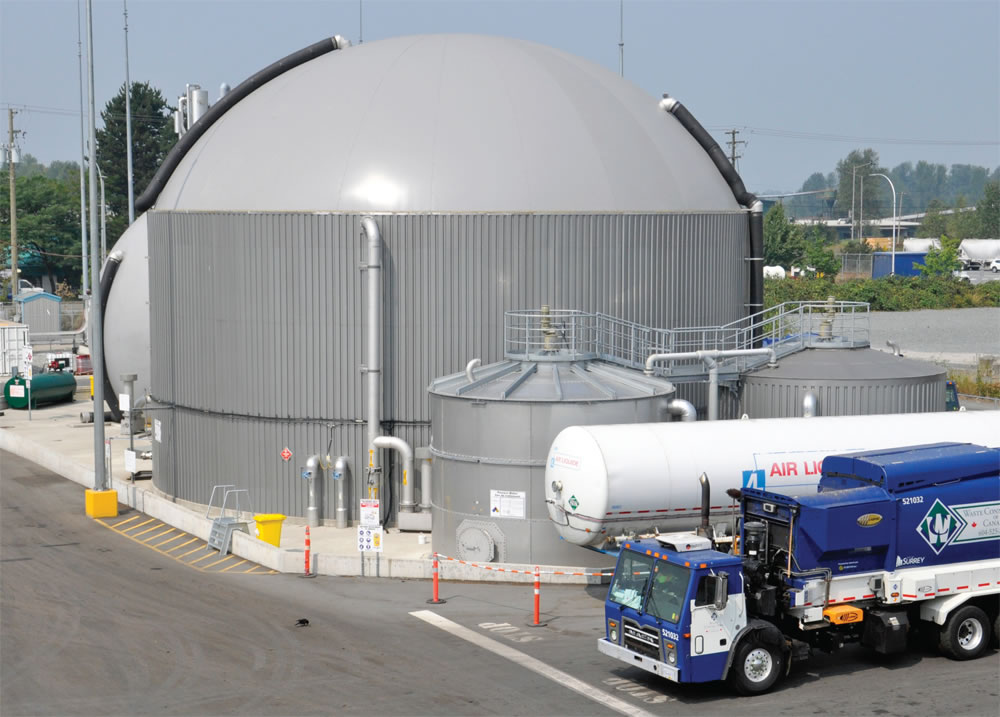The Surrey Biofuel facility employs wet and dry anaerobic digestion, and tunnel composting, to manage municipal and commercial organics.
Peter Gorrie
BioCycle September 2018
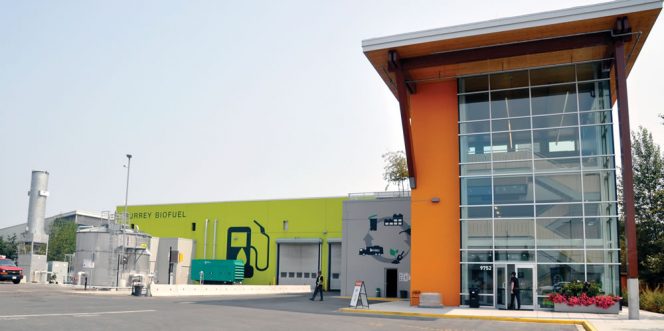
Surrey Biofuel officially opened in March, and in mid-June, started supplying RNG to the provincial pipeline grid. Photo by Peter Gorrie
The fact that Surrey Biofuel includes all three processes makes it unique in North America, notes Michael Leopold, general manager with Renewi Canada, formerly Orgaworld Canada, which won a 25-year-contract with Surrey to design, build, own, and operate the facility. The company is a division of UK-based Renewi plc, created in 2017 through the merger of Shanks Group plc and Gansewinkel B.V. “It’s not that we have any new technologies,” says Leopold. “We have multiple technologies under one roof. It’s a closed loop for the City of Surrey, from feedstock to energy.”
The project is part of a city “vision,” established eight years ago, “to fuel Surrey’s waste collection trucks with renewable natural gas generated from curbside organic waste,” a weekly service using green-lidded carts in five sizes ranging from 18 to 82 gallons, explains Ela Lukowska, the city’s biofuel project manager. It is “what we feel is the most impactful use, both environmentally and economically, of the processed organic waste.”
Adds Rob Costanzo, Surrey’s general manager, corporate services: “As far as we’re aware, Surrey is the first municipality [in Canada] to achieve corporate [city] carbon neutrality exclusively through the introduction of alternative business practices and new technologies,” rather than purchasing carbon credits.
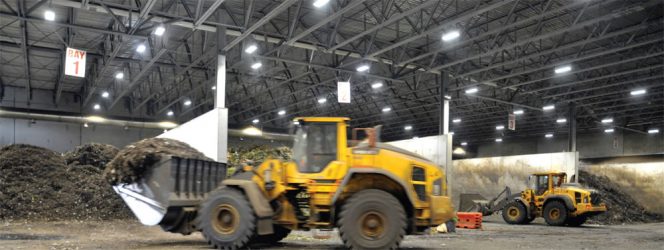
After being weighed, collection trucks from Surrey and other feedstock providers unload into one of seven receiving bays in the main building. Front-end loaders then put the material into a shredder. Photo by Peter Gorrie
RNG Offtake
The facility began receiving feedstock last December, officially opened in March and, in mid-June, started supplying RNG to the provincial pipeline grid operated by FortisBC. It can process about 127,000 tons of organics annually, and is at about two-thirds of its capacity now. Surrey, whose population has increased from 477,000 to about 540,000 in the past five years, now collects 72,000 tons/year, but expects to hit the facility’s capacity by 2043, when the contract expires. In the meantime, additional feedstock will come from the commercial sector as well as nearby municipalities. The recent announcement by Harvest Power that it is closing its composting facility in nearby Richmond could result in an increased flow of organics.
The contract with Renewi calls for minimum annual RNG production of 100,000 gigajoules, to be used in part to indirectly fuel the city’s fleet of 40 waste collection trucks, about one-quarter of its service vehicles, and part of the operation of a new District Energy System, which is to provide heat and hot water to high density residential, commercial and institutional buildings in Surrey’s City Centre. At that production rate, it would reduce annual greenhouse gas emissions by about 54,000 tons — the equivalent of taking more than 10,000 cars off the road — and eliminate the City of Surrey’s carbon footprint (generated by city operations) of nearly 20,000 tons/year.
This year’s RNG production is expected to hit 120,000 gigajoules. Renewi says it could reach 200,000 gigajoules with an “aggressive” mix of SSO and high-value liquid streams but, for now, that scenario is unlikely.
Surrey owns 100 percent of the RNG, which it sells to FortisBC at the current retail rate (about $7.11 Cdn/gigajoule at this time). It buys it back from the pipeline grid at the same rate for its vehicles and the District Energy System. If Surrey Biofuel, as expected, produces more RNG than Surrey requires, FortisBC buys this excess gas at a lower rate.
The city keeps all the revenue from sale of the excess gas up to the contract minimum (100,000 gigajules), Costanzo explains. Renewi gets a share of the revenue from any production greater than that amount, also at the lower rate. On the other hand, if RNG production falls below 100,000 gigajoules, Renewi must pay Surrey the net difference. “The more RNG they produce, the more (money) they will make,” he adds. Renewi will also keep the revenue from tipping fees and sales of the roughly 50,000 tons of compost expected to be produced annually.
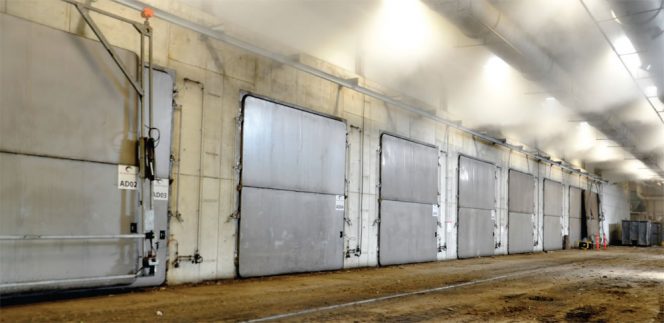
The main building houses six dry AD tunnels (above), seven aerobic composting tunnels and four hybrid tunnels, where either process can take place. Photo by Peter Gorrie
Design And Operations
The facility’s main building includes seven indoor receiving bays. It also houses six dry anaerobic digestion (AD) tunnels, seven aerobic composting tunnels and four hybrid tunnels, where either process can take place. Demand for aerobic composting increases in the spring and fall, when the incoming material includes too much leaf and yard residues for anaerobic digestion. Two of the four hybrid tunnels are now in operation, Leopold says. The others will go into service during the next 18 months, when the feedstock load increases.
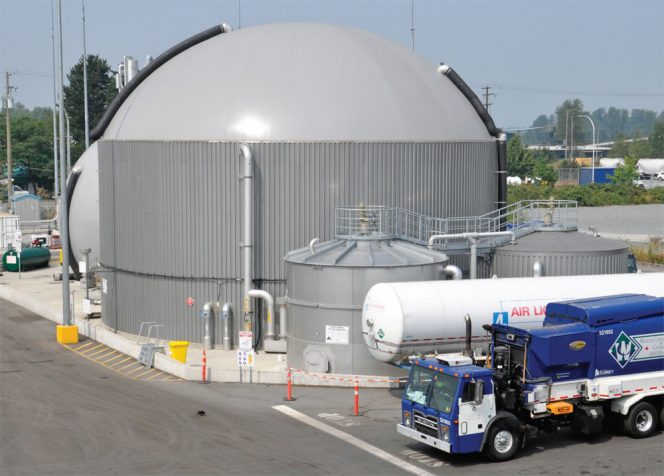
Leachate from the dry AD tunnels is collected and put into the wet AD tank along with any liquid organics that Surrey Biofuel receives. Photo by Peter Gorrie
After being weighed on an outdoor scale, collection trucks from Surrey and other feedstock providers dump their loads into one of the seven receiving bays. Next, front-end loaders put the material into a shredder that rips open any packaging and breaks the feedstock into small pieces.
Renewi chose front-end shredding over depackaging mainly because while shredding leaves small bits of plastic and other contaminants in the organic material, this gives the material structure, creating spaces around the chunks of organic matter, enhancing bacterial activity in the composting tunnels. “We don’t want a sloppy wet mess,” he explains. “We want to be sure the bugs get a lot of air.”
The shredded material goes into one of the sealed dry AD tunnels where it remains for 21 to 28 days. Loads containing a high proportion of leaf and yard residue undergo 14 days of aerobic composting in one of the hybrid tunnels. Leachate from the dry AD tunnels is collected and put into the wet AD tank along with any liquid organics that the facility receives.
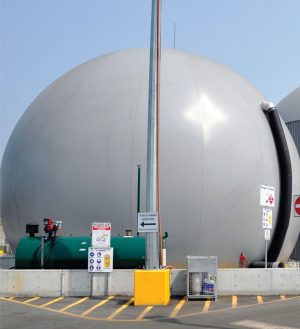
Lean biogas (too low in methane to upgrade) from the dry AD system is piped to a globe-shaped tank beside the wet AD tank and flared. Photo by Peter Gorrie
Liquid digestate from the wet tank, rich in beneficial bacteria, is heated and sprayed on to the dry AD piles to manage the temperature and dissolve the organics. Water from the composting tunnels is sprayed on the compost piles to manage moisture during the initial stage of the process.
Digestate from the dry AD tunnels is taken to the aerobic composting tunnels for 14 days of curing. It may be mixed with shredded fresh feedstock or composted material an put through the 14-day composting process. The cured compost goes through mesh and ballistic screening to remove the plastic and other contaminants.
Particles that pass through the finest screening, or less than 10 millimeters (0.4 inches), are ready for use as a soil amendment that’s 95 to 98 percent clean. Particles between 10 and 80 millimeters (0.4 and 3.14 inches) are combined with digestate from the dry AD process for further composting. The larger pieces, perhaps five tons out of every 500 tons of compost, are landfilled.
The main building is under negative pressure, created by large ceiling fans, to contain odors. Air from the tunnels goes through a scrubber where it is sprayed with sulfuric acid. That process removes ammonia from the air and creates ammonium sulfide, which can be sold for fertilizer production. The scrubbed tunnel air is then mixed with the rest of the building air, forced through a wood chip biofilter, and sent up a 230-foot dispersion stack.
Organics Flow
The City of Surrey’s organics diversion rate is now 70 percent; its goal is 80 percent by 2020. As the city grows, its organics will occupy more of the facility’s capacity. How fast that happens will depend on both population growth and how quickly the city can improve the collection rate at multiresidential and high-rise buildings, where the service began just this year.
Renewi plans to be cautious about the kinds of feedstock it will accept, with an emphasis on clean, consistent material and low levels of contaminants, adds Leopold. “As the first-of-a-kind, state-of-the-art facility we want to be able to pick and choose our customers. We want to question them … interview them as much as they interview us.”
Of particular interest is liquid organics, with their high energy content. The facility could handle 11,000 to 16,500 tons annually. Some liquid feedstock has been received and Renewi plans to accept more from commercial sources. But this is where the caution comes into play. “We spray leachate a lot,” Leopold explains, “including back on the piles to help with composting.” Liquid organics’ fat content could plug the nozzles on the spray systems.
To date, biogas production per ton of feedstock has exceeded expectations, notes Ben Poitras, Renewi’s B.C. operations manager. While “it’s hard to compare data until you’ve got months of it, gas production is on the good side.”
Surrey Biofuel employs about 15 people. Renewi covered 25 percent of the project’s cost. The Canadian government contributed 25 percent. Ownership will transfer to Surrey at the end of the 25-year contract. The facility was designed and built for a 25-year lifespan but, “with our schedule of maintenance and replacement it should be in good working order” at the end of the contract, Leopold says.
The facility has an education center, where city staff will provide workshops and tours to various audiences, including elementary and secondary students, members of the public and industry. The programs are expected to start this fall.
Peter Gorrie is a Contributing Editor to BioCycle.


